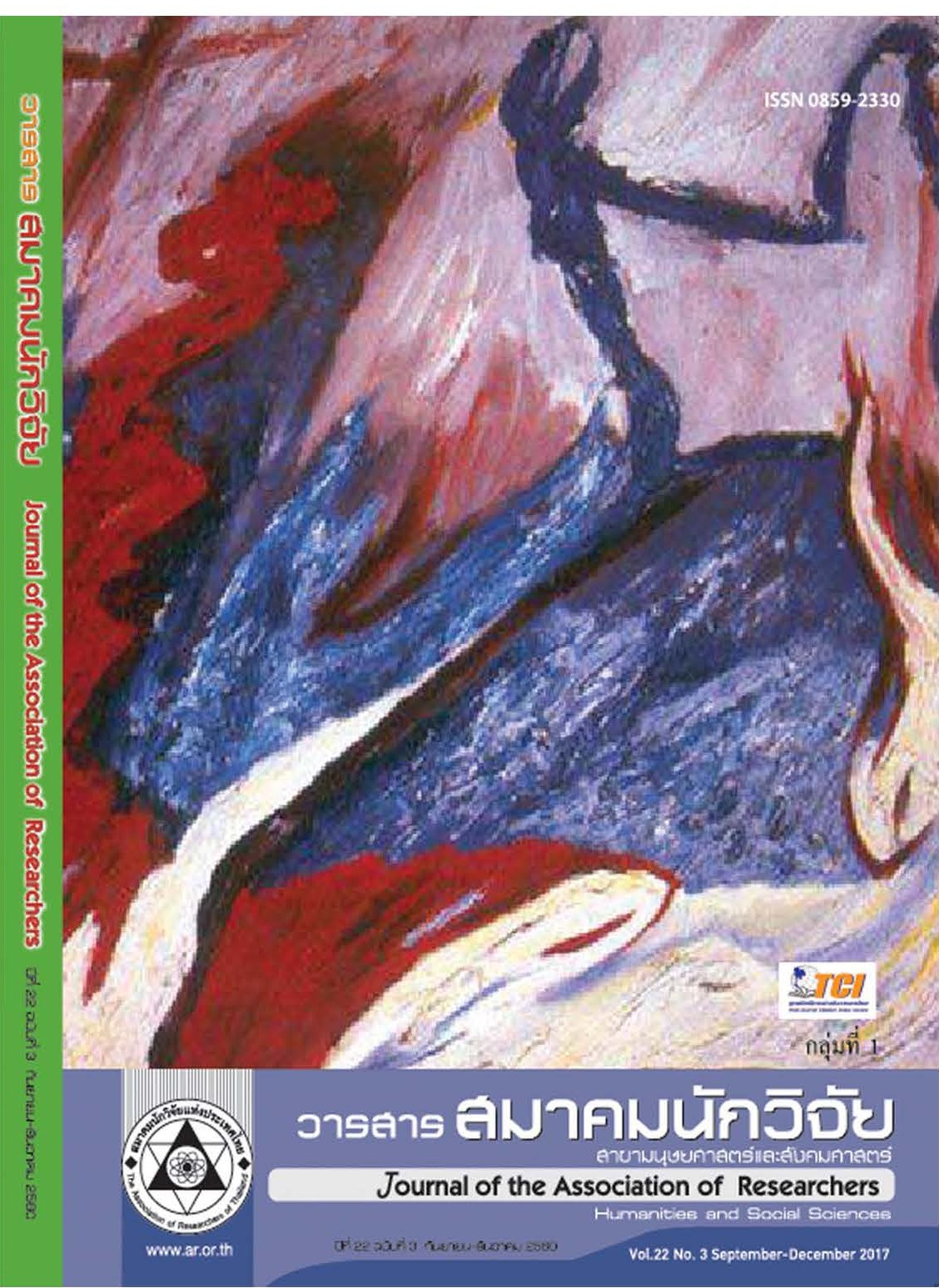he Superior Visionary Leadership and the Organizational Management of Private Higher Education Institutions in the 21st Century
Main Article Content
Abstract
objectives of this research were to study the superior visionary leadership management factors, the influence of the superior visionary leadership on organizational management to achieve goals and the types of business management with the superior visionary leadership in the 21st century. The respondents are 1,380 people, including senator and consultant of the committees on education and sport, vice presidents, teachers, and other participants, were guaranteed by reliability Cronbach's alpha (0.95). Data were analyzed using descriptive statistics (ratio, means, and standard deviation) and stepwise multiple regression analysis.
The research results have indicated that the factors of the superior visionary leadership used to manage organizations and its subordinate of Private Higher Education Institutions. In order to achieve the highest and effective goals consist of sufficiency economy, ethics and moral, superior visionary competency, visionary behavior, and visionary culture, respectively. In addition, the superior visionary leadership had a statistically significant positive effect on organizational effectiveness up to 64 % (R = 0.64, sig .000), which compose of the sufficiency economy and superior visionary competency. Finally, The superior visionary leadership model in the 21st Century is managing superior visionary leadership in the digital era, using technology for searching for information, which completely different from the previous era. More specifically, the leader at all levels and other relevant people should develop their attributes and behaviors of leadership to be consistent with the context of the organization and its sub-entities. To define the expected goals of the 21st Century mission as motivation in collaboration to successful, by using the balance of sufficiency economy principle, superior visionary competency, and other leading factors.
Article Details
บทความที่ปรากฏในวารสารนี้ เป็นความรับผิดชอบของผู้เขียน ซึ่งสมาคมนักวิจัยไม่จำเป็นต้องเห็นด้วยเสมอไป การนำเสนอผลงานวิจัยและบทความในวารสารนี้ไปเผยแพร่สามารถกระทำได้ โดยระบุแหล่งอ้างอิงจาก "วารสารสมาคมนักวิจัย"
References
ดุษฎีรัตน์ โกสุมภ์ศิริ. (2558), ภาวะผู้นําแบบดุลยภาพ – ภาวะผู้นําสําหรับศตวรรษที่ 21. วันจันทร์ที่ 21 กันยายน พ.ศ. 2558 ค้นเมื่อ 20 มีนาคม 2560 จาก http://leader1234.blogspot.com/
นฤมล โยคานกุล. (2556). ภาวะผู้นําการเปลี่ยนแปลงของผู้บริหารสถานศึกษาขั้นพื้นฐาน สังกัดองค์การบริหารส่วนจังหวัดนครราชสีมา, สารนิพนธ์พุทธศาสตรมหาบัณฑิต บัณฑิตวิทยาลัย (การบริหารการศึกษา มหาวิทยาลัยมหาจุฬาลงกรณราชวิทยาลัย)
ณัฐพันธ์ เขจรนันทน์. (2552). การจัดการเชิงกลยุทธ์: กรุงเทพฯ: ซีเอ็ดยูเคชัน
นิกัญชลา ล้นเหลือ. (2554) โมเดลสมการโครงสร้างภาวะผู้นําเชิงวิสัยทัศน์ของผู้บริหารสถานศึกษาขั้นพื้นฐาน ดุษฎีปรัชญาดุษฎีบัณฑิต มหาวิทยาลัยขอนแก่น
พิพัฒน์ นนทนาธรณ์. (2553). ภาวะผู้นําเชิงปฏิบัติการ: พิมพ์ครั้งที่ 2 กรุงเทพฯ :ศูนย์ผู้นําธุรกิจเพื่อสังคม, 223.
ณิชชา อนุกูลประเสริฐ (2551). แบบภาวะผู้นําของอธิการบดีมหาวิทยาลัยฟาร์อีสเทอร์น, วิทยานิพนธ์ ศึกษาศาสตร์มหาบัณฑิต สาขาวิชาการบริหารการศึกษา) มหาวิทยาลัยเชียงใหม่,
สัมฤทธิ์ กางเพิ่ง. (2557). ภาวะผู้นําเชิงวิสัยทัศน์: แนวคิด ทฤษฎี และกรณีศึกษา มหาสารคาม : อภิชาตการพิมพ์ 14 สุเทพ พงศ์ศรีวัฒน์. (2560), Leadership 39: ภาวะผู้นําแปบเหนือชั้น (The Transcendental Leadership) ค้นเมื่อ 27 มีนาคม 2560 จากเว็บไซต์ Suthep.crru.ac.th/
Anukulprasert, Wanicha. (2008). Leadership styles of the Far Eastern university's president, Education Master Degree, Chainmail University. (in Thai).
Avery, G. C., and Bergstein. H. (2016). Sufficiency Thinking. Hang Tai Printing Company Limited. China. 239, 244
Bass, B. M., and Avolio, B. J. (1990). The four is Transformational Leadership. Journal of European Industrial Training. 15
Bateman, Snell & Konopaske. (2017). Management Leading & Collaborating in a Competitive World (20th ed.) McGraw-Hill Education international Editio. The USA. p.1, 380, 389.
Caldwell, B.J., and Spinks, J. M. (1990). The Self - Managing School: Tayor and Francis (Mimeographed). Administrative Science Quarterly. London.
Chayakarn Nonthanathorn, (2015). Life Model: Operational Leadership, (2nced). Pimdeekarnpim Co.,Ltd.Bangkok, 288 (in Thai).
Crawford, M., Kydd, L., and Riches, C. (2002). Leadership and Teams in Educational Management. (5th ed). McGraw-Hill Education (UK).
Crossan M., Vera D., & Nanjad L. (2008). The Leadership Quarterly Transcendent leadership: Strategic leadership in dynamic environments Volume 19, Issue 5, October 2008, Pages 569-581 from https://www.scopus.com/record/display.uri?eid=2-52.0-52749085935&origin=inward&txGid=01c9c74847370 ddadec8a3%25baa0068
Daft, R. L. (2001). The leadership experience (5th ed.). London: Harcourt Brace College. 142 users AWAVUTADOU Un 22 Juun 3 women - W2109 2560
Drucker, P. F. (1994). The Age of Social Transformation. The Atlantic Monthly. Dubrin, A.J. (1998). Leadership research finding: Practice and skills. Boston: Houghton Mifflin. Kajornnan, Nattapan. (2009). Strategic management. (new version) Bangkok: Sea-Ed Yukon. 15
Graduate Volunteer Institution, Thummasart University. (in Thai). Kangpheng, Samrit. (2551). Visionary Leadership Concepts, Theories, Aphichat printing Mahasar Mahasarakham province, 14 (in Thai).
Kosumsiri, Dusadeerat. (2015). Scholarly Article: Equilibrium Leadership - Leadership for 21st Century from http://leader1234.blogspot.com/2015/09/21-scholarly article equilibrium.html (In Thai).
Mosley, J. C., Cook, P.S., Griffis, A. J., and O'Laughlin, J. (1997). Guidelines for managing cattle grazing in riparian areas to protect water quality: Review of research and best management practices policy. Idaho Forest, Wildlife, and Range Policy Analysis Group. Report No. 15. Strategic management.
Nahavandi, A. (2015). The Art and science of Leadership (7thed.). Pearson Education Limited. The USA. 288,352
Nikanchala Lonlua. (2011). Dissertation: A Structural Equation Model of Visionary Leadership for Basic. School Administrators. Doctor of Philosophy Thesis in Educational Administration. Graduate school. Khonkaen University from phd.mbuisc.ac.th/KKU_Thesis/Nikanchala.pdf (in Thai).
Podsakoff, P. M., Aheame, M., and Mackenzie, S. B. (1997). Organizational citizenship behavior and the quantity and quality of workgroup performance. Journal of Applied Psychology. 82(2): 262-70.
Pongsriwat, Suthep. (2560). Leadership 39: The Transcendental Leadership from the web: suthep.crru.ac.th/
Thompson, R. L. (2005). The US Farm Bill and Doha Negotiations: On parallel tracks or a collision course? A PC issue Brief. Received March 20, 2017, from http://www.agritrade.org/Publications/1Bs/329701.pdf (in Thai).
Rujithamrongkul, Krisdaporn. (2015). Business Administration. Bangkok, Thonburi University (in Thai).
Tichy, N. M, and Devanna, M. A. (1986). The Transformational Leader. New York: John Wiley&Sons, Inc. 306.
Victor S.L. Tan. (2000). Changing Your Corporate Culture. The New Straits Times.
Waterman, R. H. Jr. (2012). Organization Theory & Advance Strategic Management: Concept and Theory.Received March 20, 2017, from http://promrucsa-dba04.blogspot.com/2012/10/robert-hwatermanjr.html
Wilmore, E. L. (2002). Principal leadership: Applying the new educational leadership constituent council (ELCC) standards. A Sage Publications Company.
Yokhanugul, Naruemon. (2013). Thesis: Leadership Transformation of Basic School Administrators. Affiliated with Nakhon Ratchasima Provincial Administrative Organization Master Thesis College (Educational Administration) Mahachulalongkornrajavidyalaya University (in Thai).


